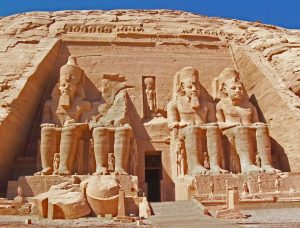The modern village of Abu Qir is situated on the western point of Abu Qir Bay on the Mediterranean coast 19km east of Alexandria. Ancient Greek writers describe two decadent cities, Canopus and Herakleion, lying here at the mouth of the now-extinct Canopic branch of the Nile. The cities, which began to decline in fortune after the founding of Alexandria in 331 BC, were mysteriously swallowed by the sea.

A wealth of ancient texts has tried to document the cities. Herodotus visited Canopus during the 5th century BC, while Strabo visited Heraklion centuries later at the beginning of the first millennium and Seneca, writing around the same time, condemned the cities as self-indulgent and corrupt.
Decree of Canopus
The cities’ original wealth seems to have derived from the collection of taxes on goods coming into the coastal ports to be shipped upriver. The famous ‘Decree of Canopus’, issued by priests assembled at Canopus in 238 BC in honor of Ptolemy III Euergetes which was found at Tanis by Karl Lepsius offered a trilingual text which has been of enormous value in studying the ancient Egyptian language, comparable to the Rosetta Stone.
Greek legend states that the city of Canopus was named after the Homeric pilot of Menelaus, who was said to have stayed in Heraklion after the Trojan wars. Likewise the city of Heraklion, according to Herodotus, was named after Heracles, who was also of the Homeric fame only.
Canopic Jars
The inhabitants of Canopus were known to have worshiped human-headed jars as the personification of Osiris and depicted on some Roman coins from the Alexandrian mint, an image which provided early Egyptologists with a name for the human-headed jars used for the burial of viscera during the mummification process. It is, however, a misconception that ‘Canopic jars’ found in tombs had anything to do with the town of Canopus, but the name has stuck.
About Herakleion and the Abu Qir
For many centuries we have known of the existence of Canopus and Herakleion and the Abu Qir area has been visited by many travelers since the 18th century, who would follow the shoreline in the hope of finding evidence of the ruined cities.
Submerged cities have long captured the imaginations of travelers everywhere and Canopus is no exception, but until recently we have had no documented evidence of what catastrophic disaster could have happened to cause the sudden and total disappearance of these cities, probably around the 8th century AD. Speculation by scholars has been varied – earthquake, flood, subsistence collapse and a rise in sea levels have all been suggested.
The spectacular discovery of the almost intact ruins of East Canopus and Herakleion was announced in 1999 following an expedition by a team of French marine archaeologists directed by Franck Goddio.
Since then, with the aid of the latest methods in underwater technology, the European Institute for Underwater Archaeology in collaboration with the Egyptian Supreme Council of Antiquities has made many exciting discoveries during several seasons diving off the coast of Abu Qir Bay.
The tremendous importance of the site lies in its existence before the foundation of Alexandria and in the fact that its monuments have been largely preserved, unlike the underwater ruins in Alexandria Bay.
There are many years of work ahead for the divers, archaeologists, and historians who make up the international team, which will undoubtedly reveal a great deal of information on the economic and cultural relationships which existed between Egypt and Greece during the late pharaonic period.